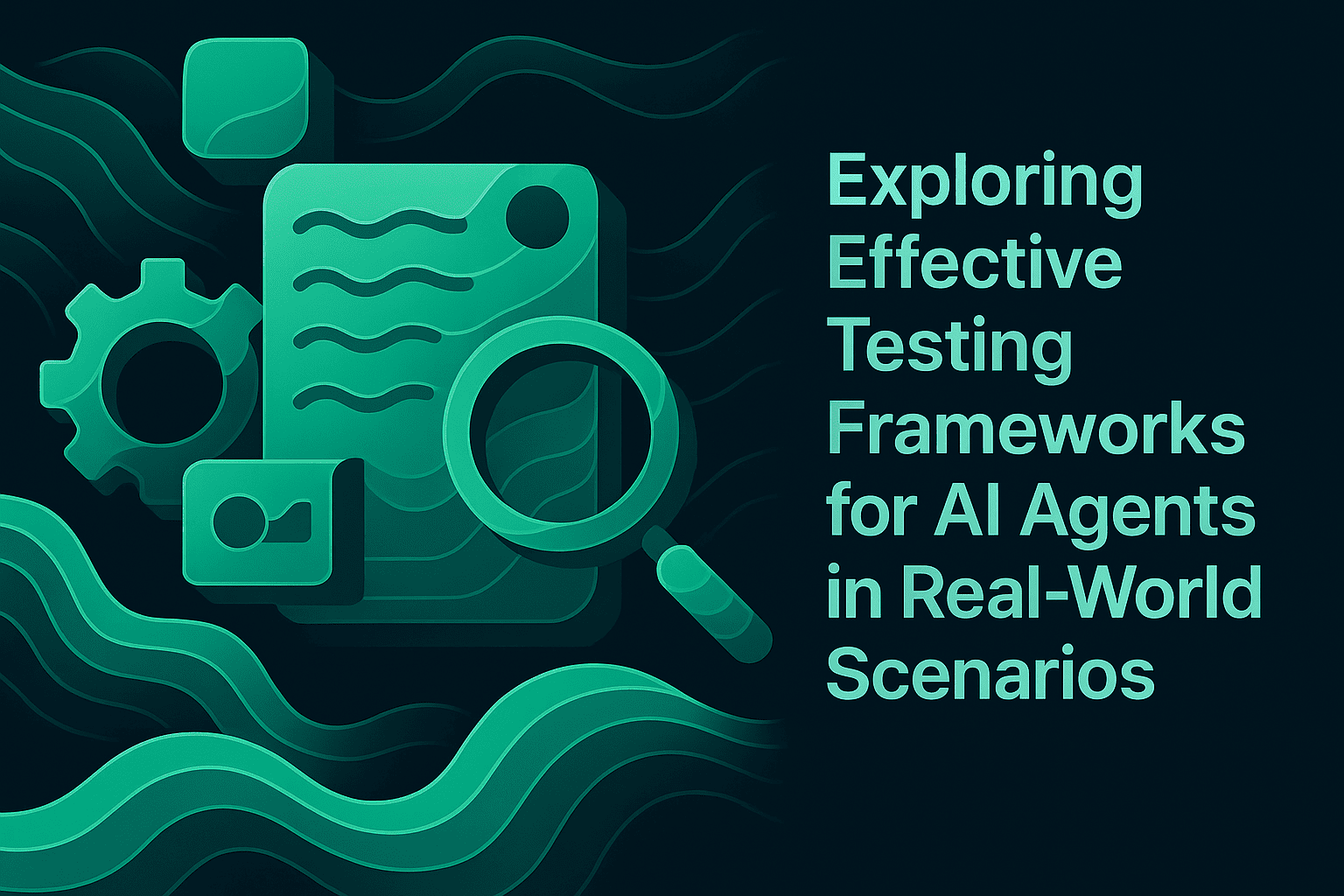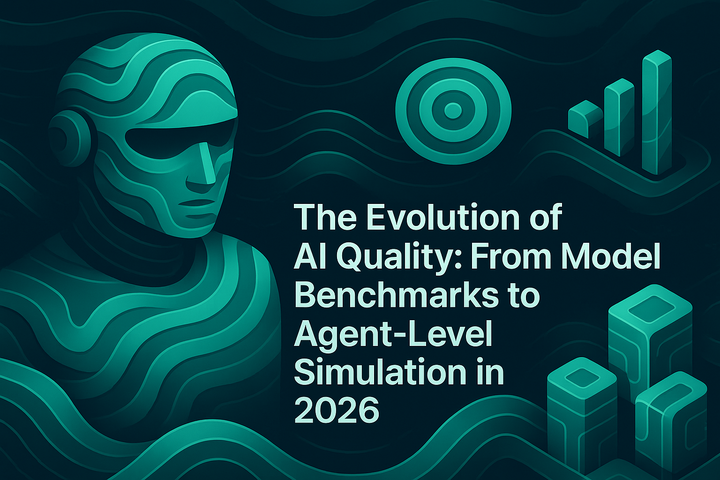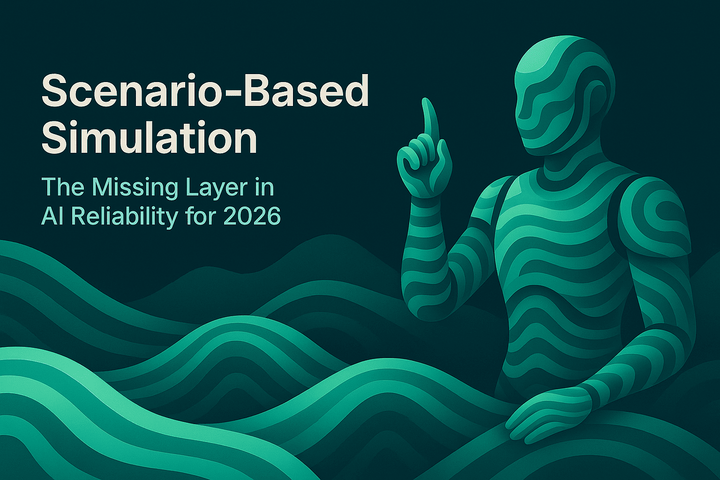Exploring Effective Testing Frameworks for AI Agents in Real-World Scenarios

TL;DR
Testing AI agents requires fundamentally different approaches than traditional software testing. Current evaluation of AI agents is predominantly focused on accuracy metrics that measure task completion success, but this offers an incomplete picture of overall agent performance and utility. Effective testing frameworks must evaluate not just outputs, but the entire sequence of actions, reasoning pathways, and outcomes across diverse real-world scenarios. This comprehensive guide explores proven frameworks, evaluation methodologies, and best practices for ensuring AI agents perform reliably in production environments.
Understanding the AI Agent Testing Challenge
Traditional software testing relies on deterministic inputs and outputs, but AI agents operate differently. Unlike typical systems, LLM agents can call tools in varying sequences with different inputs, invoke other sub-agents each with its own set of goals, and generate non-deterministic behaviors based on state, memory, or context. This complexity demands evaluation at multiple levels rather than simple pass-fail assertions.
The transition from rule-based automation to agentic systems introduces serious reliability concerns. Organizations face hallucinations, misjudgments, and security vulnerabilities that can carry real operational and reputational consequences. According to LangChain's 2024 State of AI Agents report, teams often struggle with the technical know-how required to work with agents, including implementing them for specific use cases, and the time investment needed to build and deploy agents reliably.
Real-world challenges extend beyond technical limitations. While specialized agents showed impressive capabilities in narrow domains, general-purpose agents still struggled with complex, open-ended tasks, achieving only 14.41% success rates on end-to-end tasks in WebArena compared to 78.24% for humans. This performance gap underscores the critical need for comprehensive testing frameworks that can identify and address agent limitations before deployment.
Core Components of AI Agent Testing Frameworks
Multi-Level Evaluation Architecture
Effective agent testing operates across three distinct levels, each addressing different aspects of system behavior:
Level 1: Component-Level Testing Component-level evaluation assesses individual agent capabilities such as perception, reasoning, action selection, and learning in isolation. This includes validating that retrieval mechanisms return relevant context, tool selection logic chooses appropriate functions, and individual prompts generate expected outputs.
Level 2: Integration Testing Integration testing ensures modules communicate correctly, because even if memory retrieval and planning work independently, they might mismatch data formats when combined. Teams must verify that data flows smoothly between components and that the agent handles state transitions appropriately across multi-turn conversations.
Level 3: End-to-End Simulation End-to-end simulation replicates real user sessions or workflows to see emergent issues like repeated calls to the same API or contradictory sub-task planning. This level reveals how the agent behaves under realistic conditions with all components working together.
Evaluation Metrics Beyond Accuracy
Comprehensive metrics should cover various aspects such as task completion rate, response time, and compliance with predefined policies. Critical metrics include:
- Task Completion Rate: Measures whether agents accomplish assigned objectives within simulation environments
- Error Rate: Identifies the frequency of mistakes or deviations from expected behavior
- Response Time: Tracks the speed at which agents react to inputs, critical for time-sensitive applications
- Tool Selection Accuracy: Evaluates whether agents choose appropriate tools and pass correct parameters
- Reasoning Quality: Assesses the logic and efficiency of decision-making pathways
Beyond automated metrics, human insight remains indispensable for identifying subtle biases that automated checks might miss, especially in sensitive domains. Successful frameworks combine quantitative measurements with qualitative human evaluation to ensure comprehensive coverage.
Simulation-Based Testing Approaches
Simulation testing has emerged as the gold standard for evaluating agent behavior in controlled yet realistic environments. Unlike static input-output testing, simulations test your agent's behavior in realistic, multi-turn conversations that mimic how real users would interact with your system.
Scenario Design and User Persona Modeling
Effective simulations require carefully designed test scenarios that span routine interactions to edge cases. Projects like τ-Bench offer conversation-based test scenarios that challenge AI to manage multiple tasks while adhering to specific policies, revealing how effectively the agent handles rule-following, long-term planning, and unexpected developments.
User persona modeling adds another dimension to simulation testing. AI-powered simulations enable teams to test agents across hundreds of scenarios and diverse user personas, monitoring how agents respond at every step of customer interactions. This approach uncovers behavioral issues that might only emerge with specific user types or communication styles.
Conversational Flow Testing
Simulations complement evaluations by testing the agent as a whole, specifying how middle steps should be evaluated and considering the conversational flow that traditional tests ignore. For production-grade agents, teams should define entire conversation scripts that include:
- User inputs at each turn
- Expected agent responses and reasoning
- Required tool calls with parameter validation
- State management and context preservation
- Error handling and recovery paths
Maxim's simulation platform allows teams to simulate multi-turn interactions across diverse scenarios, evaluate agents at a conversational level analyzing the trajectory chosen, and re-run simulations from any step to reproduce issues and identify root causes.
Production-Grade Testing Infrastructure
Moving from demos to reliable production systems requires treating evaluation as a first-class component of your development pipeline. Teams need standardized evaluation harnesses with reusable frameworks for defining tasks, running agents, and capturing detailed execution traces.
Continuous Evaluation Pipelines
Organizations should treat simulations like unit and integration tests for agents, running a sanity set of simulations with strict gates on every prompt or model change, executing the full suite nightly with expanded personas and randomized tool failures, and including safety and compliance sweeps for release candidates.
Automated pipelines should integrate with your CI/CD workflow, blocking deployments when critical metrics fall below thresholds. Maxim's evaluation framework enables teams to wire simulations into development flows using automated evaluation pipelines and reporting, comparing runs with dashboards to identify regressions before they reach production.
Regression Testing and Model Updates
Organizations must implement trace-based observability to analyze agent behavior over time, manage prompt versions, run A/B tests, and compare model performance across deployments. When updating underlying models or modifying prompts, regression testing ensures that improvements in one area don't degrade performance elsewhere.
Key practices include:
- Maintaining versioned test suites tied to specific releases
- Capturing execution traces for debugging and analysis
- A/B testing different configurations with statistical rigor
- Monitoring drift in agent behavior over time
Prompt management becomes critical as agents evolve. Teams should version prompts directly from the UI for iterative improvement and deploy prompts with different deployment variables and experimentation strategies without code changes.
Evaluation Frameworks and Methodologies
Progressive Evaluation Stages
A systematic approach to agent assessment begins with basic capability testing and progresses through increasingly challenging and realistic evaluation contexts, from component-level evaluation through integrated system evaluation to controlled scenario testing.
This staged approach allows teams to identify issues early when they're cheaper to fix, validate that improvements at one level translate to better end-to-end performance, and build confidence progressively as agents pass each evaluation gate.
AI-as-Judge Evaluation
LLM-based evaluation has become increasingly sophisticated for assessing subjective qualities like tone, helpfulness, and adherence to brand guidelines. One promising capability is self-evaluation, where models can apply judgment criteria to their own output, defining what good versus bad output looks like, adding scoring rubrics directly into prompts, and reviewing responses against those criteria.
Maxim's evaluation library includes pre-built evaluators for clarity, conciseness, faithfulness, and toxicity detection, alongside support for custom evaluators using LLM-as-a-judge, programmatic checks, and statistical measures.
Human-in-the-Loop Evaluation
Despite advances in automated testing, human evaluation remains essential for catching subtle failures that dashboards miss. Teams should periodically recalibrate evaluators with human reviews on high-risk flows, continually evolve datasets to include new features and edge cases, and track versions linked to releases.
Human annotation workflows enable product teams to conduct last-mile quality checks and nuanced assessments without becoming bottlenecked by engineering dependencies. This cross-functional approach accelerates iteration while maintaining quality standards.
Safety, Security, and Guardrails
Production agents require robust safety measures beyond functional correctness. Real-time guardrails serve as a safety net that stops or mitigates harmful or policy-violating actions before they escalate, through dynamic constraint enforcement, live monitoring and anomaly detection, and graceful escalation for sensitive requests.
Adversarial Testing
Security vulnerabilities introduce new attack surfaces. Microsoft researchers identify novel threats like memory poisoning and prompt injection, where AI email assistants can be poisoned via specially crafted emails, incorporating malicious instructions into internal memory and then forwarding sensitive correspondence to attackers.
Testing frameworks must include adversarial scenarios that attempt to:
- Override agent instructions through prompt injection
- Extract sensitive system information
- Trigger harmful actions through edge cases
- Exploit tool calling mechanisms
- Manipulate agent memory and context
Security evaluators help detect personally identifiable information leakage and validate that agents respect data privacy boundaries.
Regulatory Compliance Testing
The EU's AI Act, effective 2024, classifies many enterprise AI applications as high-risk and mandates lifecycle risk management, high accuracy standards, data governance, transparency, and human oversight for critical systems. Organizations must establish testing protocols that demonstrate compliance with regulatory requirements.
This includes maintaining logs of agent decisions, enabling human intervention capabilities, documenting evaluation methodologies, and providing audit trails for critical interactions. Observability platforms track, debug, and resolve live quality issues with real-time alerts to minimize user impact while maintaining compliance standards.
Data Management for Agent Testing
High-quality test data forms the foundation of effective evaluation. A case study in the financial sector found that when AI models were fine-tuned on specialized datasets comprising complex trading scenarios, predictive accuracy improved compared to models trained solely on general financial data.
Dataset Curation Strategies
Comprehensive testing requires datasets that represent the full spectrum of real-world scenarios. Teams should:
- Import production traces to capture actual usage patterns
- Generate synthetic data for edge cases and rare scenarios
- Curate datasets with human-in-the-loop workflows
- Create domain-specific test suites for specialized applications
- Maintain separate datasets for different evaluation purposes
Maxim's data engine enables seamless data management, allowing teams to import datasets including images with a few clicks, continuously curate and evolve datasets from production data, and create data splits for targeted evaluations and experiments.
Balancing Standard and Custom Datasets
By combining standard and custom datasets, teams obtain a comprehensive view of the AI agent's strengths and weaknesses, ensuring all aspects of real-world usage are considered. Standard benchmarks provide industry comparisons and baseline performance metrics, while custom datasets validate agent behavior for specific business contexts and requirements.
Real-World Implementation Case Studies
Enterprise Agent Deployments
Microsoft's Copilot for Microsoft 365 has shown a 70% increase in productivity for routine tasks, measured through metrics such as a 30% increase in code development speed, a 20% reduction in code errors, and a 40% improvement in overall developer satisfaction. These results stem from rigorous testing and evaluation throughout development.
One team reported they'd save $240K over 2 years versus Selenium, while another said they went from 2 weeks of work to 2 hours using autonomous testing approaches. Such improvements only become possible through comprehensive testing frameworks that catch issues early and enable rapid iteration.
Lessons from Autonomous Systems
The stakes of inadequate testing become clear in high-risk domains. Tesla's Autopilot was involved in at least 13 fatal crashes in scenarios where attentive drivers could have intervened, with investigators concluding Tesla let Autopilot operate in situations it wasn't designed to without requiring driver attention.
This cautionary example demonstrates that deploying AI agents without exhaustive testing of edge cases and robust fail-safes can lead to tragedy. Companies must ensure clear communication of an agent's limits and rigorous safety measures are non-negotiable for consumer AI.
Practical Framework Selection Guide
Choosing the right testing framework depends on your technical requirements, team structure, and deployment context. Consider these factors:
Team Technical Expertise For rapid iteration and visual development, frameworks like n8n or Flowise work well, while complex, code-heavy experiments benefit from LangChain/LangGraph or AutoGen. Teams should match framework complexity to their actual capabilities rather than over-engineering solutions.
Enterprise Requirements Microsoft's Semantic Kernel excels at integrating AI capabilities into existing enterprise applications, providing enterprise-grade security and compliance features necessary for production deployment. Organizations in regulated industries need frameworks that support audit trails, access controls, and governance workflows.
Development Workflow Integration Successful frameworks integrate seamlessly with existing development practices. Maxim's unified platform brings experimentation, simulation, observability, and evaluation into a single workflow, enabling cross-functional teams to move faster across both pre-release and production phases.
Best Practices for AI Agent Testing
Based on industry experience and research findings, effective agent testing requires:
Start with Clear Success Criteria You need a clear, machine-readable definition of success that specifies not just what the agent should accomplish, but how it should get there. Ambiguous objectives lead to evaluation systems that miss critical failures.
Test Across the Autonomy Spectrum Different autonomy levels demand different evaluation criteria and techniques, as a basic chatbot isn't the same as a fully autonomous agent. Match your testing rigor to the agent's capabilities and risks.
Combine Automated and Manual Testing Organizations must combine automated metrics with human feedback to catch subtle failures that dashboards miss. Neither approach alone provides sufficient coverage for production systems.
Build Continuous Feedback Loops An agent that works perfectly today might fail silently tomorrow, so production evaluation can't be a one-time thing. Implement ongoing monitoring, periodic re-evaluation, and mechanisms to capture and address production issues.
Maintain Evaluation Infrastructure Building an AI agent is a sprint, but building the infrastructure to evaluate it properly is a marathon, and teams that focus on the marathon are the ones that will still be around when the initial hype dies down. Invest in maintainable, scalable testing systems from the start.
Conclusion
Effective testing frameworks for AI agents must address the fundamental differences between deterministic software and autonomous systems that reason, plan, and act. Success requires multi-level evaluation spanning component testing through end-to-end simulation, comprehensive metrics beyond simple accuracy, robust safety and security measures, and continuous monitoring in production.
By blending component testing, integration validation, simulation, guardrails, and human oversight into one continuous lifecycle, organizations build an ecosystem where agentic AI is tested, monitored, and improved at every stage from first prototypes to production deployment.
Organizations leveraging Maxim's end-to-end platform gain unified access to simulation, evaluation, and observability capabilities specifically designed for AI agents. From automated simulations that test across hundreds of scenarios to production monitoring that catches quality drift in real-time, comprehensive tooling enables teams to ship reliable agents 5x faster.
The path from impressive demos to production-grade AI agents depends on rigorous testing infrastructure. Teams that invest in proper evaluation frameworks today will build the trustworthy, reliable agents that define tomorrow's AI applications.
Ready to build reliable AI agents with comprehensive testing and evaluation? Book a demo to see how Maxim can accelerate your agent development while ensuring quality and safety, or sign up to start testing your agents today.


